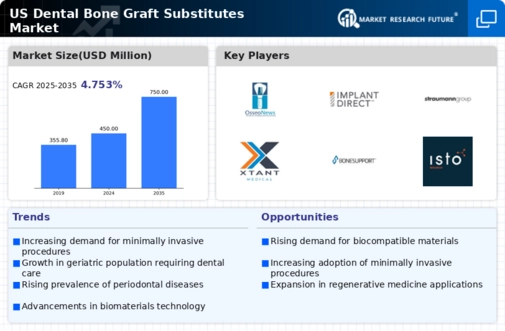Advancements in Biomaterials
Innovations in biomaterials are significantly influencing the dental bone-graft-substitutes market. The development of synthetic and natural materials that mimic the properties of human bone enhances the effectiveness of grafting procedures. For instance, materials such as hydroxyapatite and bioactive glass are gaining traction due to their biocompatibility and ability to promote bone regeneration. The market for these advanced biomaterials is projected to grow at a CAGR of approximately 8% over the next five years. As dental practitioners increasingly adopt these innovative solutions, the demand for high-quality bone-graft substitutes is likely to rise, further driving the industry.
Growing Geriatric Population
The aging population in the US is a significant factor contributing to the dental bone-graft-substitutes market. As individuals age, they become more susceptible to dental issues, including bone loss and tooth decay. The US Census Bureau projects that by 2030, approximately 20% of the population will be aged 65 and older. This demographic shift is expected to increase the demand for dental procedures that utilize bone-graft substitutes. Consequently, dental professionals are likely to focus on providing tailored solutions for older patients, thereby enhancing the market's growth potential. The industry must adapt to meet the unique needs of this population segment.
Increased Awareness of Oral Health
There is a growing awareness of the importance of oral health among the US population, which is positively impacting the dental bone-graft-substitutes market. Educational campaigns and initiatives by dental associations have led to a heightened understanding of the consequences of untreated dental issues. As patients become more informed, they are more likely to seek preventive and corrective dental treatments, including those that involve bone grafting. This trend suggests a potential increase in the number of dental procedures performed, thereby driving demand for bone-graft substitutes. The industry must capitalize on this awareness to promote innovative solutions.
Rising Incidence of Dental Disorders
The increasing prevalence of dental disorders in the US is a primary driver for the dental bone-graft-substitutes market. Conditions such as periodontal disease, tooth loss, and bone defects necessitate effective treatment options. According to the American Dental Association, nearly 70% of adults aged 35 to 44 have lost at least one permanent tooth due to injury, decay, or periodontal disease. This growing incidence creates a substantial demand for dental procedures that often require bone grafting, thereby propelling the market forward. As dental professionals seek to enhance patient outcomes, the reliance on advanced bone-graft substitutes becomes more pronounced, indicating a robust growth trajectory for the industry.
Expansion of Dental Insurance Coverage
The expansion of dental insurance coverage in the US is likely to bolster the dental bone-graft-substitutes market. As more insurance plans begin to include coverage for advanced dental procedures, patients are more inclined to pursue necessary treatments that involve bone grafting. This trend is particularly relevant as insurance providers recognize the long-term cost benefits of preventive care. The increased financial accessibility for patients may lead to a rise in the number of procedures performed, thereby enhancing the market's growth. The dental industry must continue to advocate for comprehensive coverage to support this trend.

























Leave a Comment